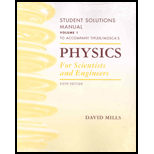
The total kinetic energy before collision in terms of
Answer to Problem 91P
The total kinetic energy before collision in terms of
Explanation of Solution
Given:
The mass of particle 1 is
The mass of particle 2 is
Formula Used:
The expression for conservation of momentum is given by,
The expression for kinetic energy before collision is given by,
The expression for kinetic energy after collision is given by,
The expression for conservation of energy is,
Calculation:
The expression for conservation of momentum is calculated as,
The expression for kinetic energy before collision is calculated as,
Further simplify the above,
The expression for kinetic energy after collision is calculated as,
Further simplify the above,
The expression for conservation of energy is calculated as,
Conclusion:
Therefore, the total kinetic energy before collision in terms of
Want to see more full solutions like this?
Chapter 8 Solutions
Physics For Scientists And Engineers Student Solutions Manual, Vol. 1
- In an elastic collision of two particles with masses m1 and m2, the initial velocities are u1 and u2 = u1. If the initial kinetic energies of the two particles are equal, find the conditions on u1/u2 and m1/m2 such that m1 is at rest after the collision. Examine both cases for the sign of .arrow_forwardA particle of mass m moving along the x-axis with a velocity component +u collides head-on and sticks to a particle of mass m/3 moving along the x-axis with the velocity component −u. What is the mass M of the resulting particle?arrow_forwardAn unstable nucleus of mass 1.7 x 10-26 kg, initially atrest at the origin of a coordinate system, disintegrates intothree particles. One particle, having a mass of m1 = 5.0 x 10-27 kg, moves in the positive y- direction with speed v 1 =6.0x 106 m/s. Another particle, of mass m2 = 8.4 x 10-27 kg, moves in the positive x - direction with speed v2 = 4.0 x 106 m/s. Find the magnitude and direction of the velocity of thethird particle.arrow_forward
- Show solution A particle A, of mass 8 kg, collides with a particle B, of mass m2 kg. The velocity of particle A before the collision was 5 m/s and the velocity of particle B before the collision was 2.2 m/s. Given the velocity of particle A after the collision was -4 m/s, and the velocity of particle B was 3 m/s, what was the mass of particle B?arrow_forwardThe force on a particle of mass mmm is given by F=28i−12t^2j where F is in N and t in s. What will be the change in the particle's momentum between t1 = 1.0 s and t2 = 3.0 s?arrow_forwardan object of mass m and velocity v collides elastically with a stationary object and continuies in the same direction with a speed of 0.25v. what is the mass of the object that was initially stationaryarrow_forward
- Ball having mass 3.4kg and velocity 7.2m/s travels to the east. Impulse given at point O, makes it change direction to north with velocity 2.2 m/s. What is the direction of the given impulse, measured in unit of degrees, if the angle is defined as between the horizontal direction (east) and the impulse?arrow_forwardConsider two particles A and B of masses m and 2m at rest in an inertial frame. Each of them are acted upon by net forces of equal magnitude in the positive x direction for equal amounts of time t. Moment of the particles A and B in centre of mass frame respectively are?arrow_forwardInitially resting in the xy coordinate plane's center, an item erupts into three parts. Immediately after the explosion, a piece of mass 2m travels with a velocity of v in the negative x direction, while another piece of mass 3m moves with the same velocity in the negative y direction. The third component has a mass of 4m. i. immediately after the explosion, what is the magnitude of the third particle's velocity in terms of the above variables? Beginning with momentum conservation is a good place to start. ii. Immediately after the explosion, what is the direction of motion of the third piece (as an angle relative to the positive x axis)?arrow_forward
- An object of mass m1=2 kg moving with velocity 12 m/s, collides head-on with an object whose mass is m2=6 kg and velocity is 1 m/s. Given that the collision is elastic, what are the final velocities of the two objects. Neglect friction.arrow_forwardProve that the linear momentum of a system of particles is conserved.arrow_forwardA golf ball of mass m = 0.18 kg is dropped from a height h. It interacts with the floor for t = 0.11 s, and applies a force of F = 17.5 N to the floor when it elastically collides with it. Randomized Variablesm = 0.18 kgt = 0.11 sF= 17.5 N Write an expression for the ball's velocity, v, in terms of the variables m, t, and F, just after it rebounds from the floor. (Hint: The fact that the collision is elastic is important when solving this problem.) What is the magnitude of the ball's velocity v, in meters per second, right after it rebounds? How high h, in meters, will the ball travel on the rebound?arrow_forward
 Classical Dynamics of Particles and SystemsPhysicsISBN:9780534408961Author:Stephen T. Thornton, Jerry B. MarionPublisher:Cengage Learning
Classical Dynamics of Particles and SystemsPhysicsISBN:9780534408961Author:Stephen T. Thornton, Jerry B. MarionPublisher:Cengage Learning Modern PhysicsPhysicsISBN:9781111794378Author:Raymond A. Serway, Clement J. Moses, Curt A. MoyerPublisher:Cengage Learning
Modern PhysicsPhysicsISBN:9781111794378Author:Raymond A. Serway, Clement J. Moses, Curt A. MoyerPublisher:Cengage Learning Principles of Physics: A Calculus-Based TextPhysicsISBN:9781133104261Author:Raymond A. Serway, John W. JewettPublisher:Cengage Learning
Principles of Physics: A Calculus-Based TextPhysicsISBN:9781133104261Author:Raymond A. Serway, John W. JewettPublisher:Cengage Learning


